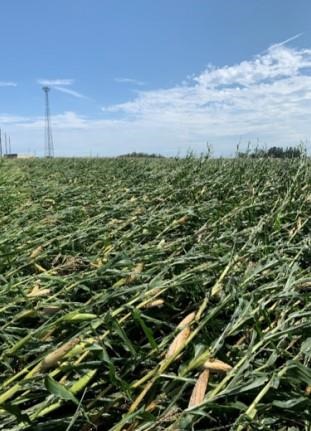By Ryan Bergman
With the recent storms rolling through northern Iowa, many growers are experiencing field conditions similar to those seen across the state after the 2020 derecho. To help ensure a safe and productive harvest, we’ve rounded up some tips and information that were developed after the derecho last fall for harvesting lodged and downed corn. While the damage from recent storms is not as widespread as last August’s derecho, some of the impacts to crops are very similar.

Figure 1. Lodged crop near Plainfield
While you may be experiencing some of the same difficulties producers saw in 2020, a few key differences in current conditions may mean a slightly better situation this fall compared to last year. First, most of the damaged corn this year was closer to physiological maturity. This should mitigate some of the concerns seen in 2020 about how to deal with completely lodged crops that were still actively growing. Second, some of the reports we have seen also indicate that the crop is lodged further up the stalk (18 to 24 inches off the ground) compared with 2020, when much of the crop was completely flattened and lodged at the soil surface. This should make the crop easier to feed into the combine head and result in lower losses than if the crop was completely lodged at the soil surface.
Source : iastate.edu